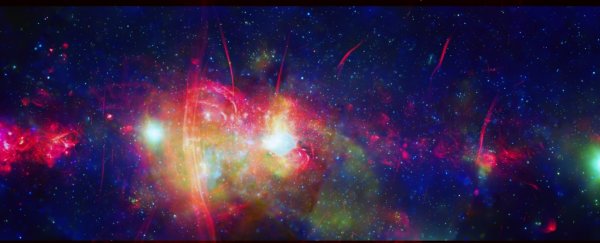The center of the Milky Way is a powerful particle accelerator, new research has revealed – but there's also some unknown mechanism blocking cosmic rays from penetrating the vast cloud called the central molecular zone.
This finding could help us better understand the origins of cosmic rays – particles such as protons and atomic nuclei that constantly stream through space at almost the speed of light.
The galactic center is a zone of mystery. We have a decent idea of what's in there, but it's so thick with dust that we can't study it in a range of wavelengths, from soft X-rays through to visible light. This has placed some limitations on what we can and can't see.
Astronomers expect that the galactic center is an important source of cosmic rays. These are protons and nuclei that have been stripped of electrons and accelerated to relativistic speeds by powerful magnetic fields. There are a number of objects in the galactic center that could act as cosmic ray accelerators: supernova remnants, pulsar wind nebulae, and the supermassive hole at the Milky Way's heart, Sagittarius A*.
According to observation data and modeling, the cosmic ray distribution throughout the Milky Way should be smooth, and more or less steady. Cosmic rays emerge from accelerators and propagate in the galactic magnetic field, where they are likely slowed and re-accelerated to result in what astronomers call a cosmic ray sea.
In order to study how cosmic rays are accelerated and transported, a source of fresh cosmic rays is required.
Luckily, cosmic rays are very energetic. This means we can detect them in the galactic center, because that energy range produces light in the limited wavelength range that penetrates the dust there.
Cosmic rays can interact with the interstellar medium – gas and dust that hangs around in the space between the stars – and this interaction in turn produces high-energy gamma-ray photons, with about 10 percent of the energy of their cosmic ray parents.
Led by astronomer Xiaoyuan Huang of the Chinese Academy of Sciences, a team of researchers looked at the gamma radiation in the central molecular cloud of the Milky Way using data from the Fermi Large Area Telescope, hoping to find these sources of fresh cosmic rays.
They found gamma rays that did suggest, as expected, that the galactic center is a high-energy particle accelerator – or at least, something in the region is. But they also found something really surprising.
According to the team's calculations, the density of cosmic rays in the central molecular cloud is lower than the density of the cosmic ray sea. This suggests the presence of some kind of barrier that is preventing cosmic rays from penetrating the central molecular cloud.
Exactly what this barrier consists of will need to be the subject of future research, but there are several intriguing possibilities.
Molecular clouds are complicated places. The collapse of denser parts of the cloud can result in compression of magnetic fields; that could be a barrier. Another could be magnetohydrodynamic turbulence.
Here in the Solar System, cosmic rays are modulated by the solar wind. It's possible that, in the galactic center, the galactic wind fulfils a similar role. The team calculated the cosmic ray density in the presence of a galactic wind, and returned a similar result to their analysis of the gamma ray data.
Future work to explore this phenomenon in more detail may help rule out some of the mechanisms that could be causing it.
In addition, more detailed, three-dimensional modeling of the galactic center could help shed more light on the origin and transport of cosmic rays in the Milky Way, the researchers say. There's always more out there to be found, indeed.
The research has been published in Nature Communications.
